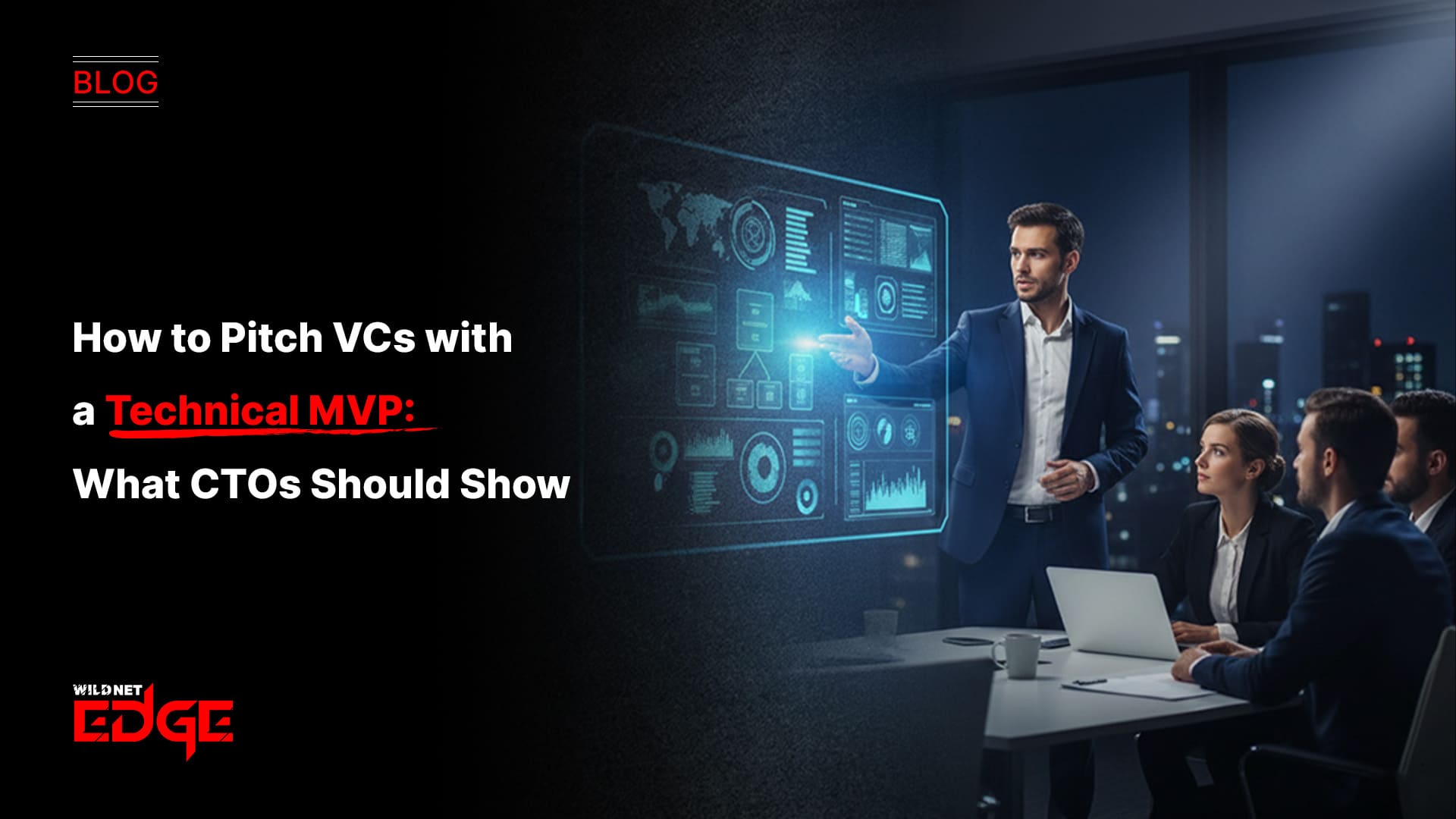TL;DR
This article provides a strategic guide for CTOs on presenting a technical Minimum Viable Product (MVP) to venture capitalists. It explains that an MVP for investors is more than a demo; it’s tangible proof of technical feasibility and market potential. The guide outlines what constitutes an investor-ready MVP, emphasizing core functionality, a clean user experience, and underlying technical competence. It details key aspects CTOs should highlight in their pitch, including the scalable architecture, the chosen technology stack’s rationale, and initial user feedback. Presenting a clear software roadmap beyond the MVP is also crucial for showing long-term vision and de-risking the investment.
Pitching to venture capitalists (VCs) is a high-stakes moment for a startup founder. While the CEO focuses on the market opportunity and business model, the CTO plays an equally critical role: convincing investors that the technology is sound, scalable, and capable of delivering on the vision. In this context, having more than just an idea is paramount. A well-built Minimum Viable Product (MVP) is your most powerful asset. Knowing how to present this technical MVP for investors is key to securing the funding you need to grow.
What is an Investor-Ready MVP?
An MVP for investors is not just a basic prototype or a proof of concept software. It is the simplest, functional version of your product that solves a core problem for a specific target audience and demonstrates the technical viability of your solution. It should be:
- Functional: It actually works and delivers the core value proposition.
- Focused: It includes only the essential features needed to validate the core hypothesis.
- Usable: It provides a positive, albeit limited, user experience.
- Demonstrable: It clearly shows the potential of your technology and your team’s ability to execute.
This investor-ready MVP serves as tangible evidence that your idea is more than just slides; it’s a real product with market potential.
Why an MVP is Crucial for Your Startup Pitch Technology
Venture Capitals hear hundreds of pitches. An MVP fundamentally de-risks the investment for them. Research consistently shows that startups with a working product have a significantly higher chance of securing funding compared to those pitching just an idea. Data from sources like First Round Capital suggests that demonstrating traction, even with an early product, is a key factor in successful fundraising.
Presenting a functional MVP demonstrates:
- Technical Feasibility: You’ve proven the core technology can be built.
- Team Capability: Your team can actually execute and ship a product.
- Market Validation (Initial): Even limited user feedback or early metrics are powerful proof points.
- Reduced Time-to-Market: You are closer to generating revenue than a pre-product startup.
A strong technical presentation is a critical part of the startup pitch technology narrative. Expert MVP Development ensures this foundation is solid.
What CTOs Should Show VCs About the MVP
When presenting the technical aspects of your MVP for investors, focus on demonstrating competence, foresight, and a clear path forward. Your CTO pitch deck MVP section should cover:
1. The Core Functionality (Live Demo)
A crisp, focused live demo of the MVP’s core feature loop is essential. Highlight how it cleanly and efficiently solves the user’s primary pain point. Keep it brief and avoid features that are buggy or incomplete.
2. The Underlying Architecture
You don’t need deep technical diagrams, but briefly explain the architectural choices you made and why.
- Scalability: How is the system designed to handle growth? Mention if you used a microservices approach or designed for horizontal scaling. A scalable architecture for startups is a key concern for VCs.
- Technology Stack Rationale: Briefly justify your choice of major technologies (backend language, database, cloud provider). Focus on factors like performance, scalability, security, and developer availability. Demonstrate thoughtful decision-making.
3. Initial User Feedback and Metrics
Even qualitative feedback from a handful of early users is valuable. Quantitative data (like early retention or engagement metrics) is even better. Show that you are already learning from the market. This adds credibility to your startup pitch technology.
4. The Technical Roadmap Beyond MVP
Investors are funding the future, not just the current MVP. Present a clear, high-level software roadmap for startups.
- Phase 2 Features: Based on your validated learnings, what key features are coming next?
- Long-Term Vision: How will the technology evolve to capture the larger market opportunity?
- Technical Challenges: Acknowledge potential future technical hurdles (e.g., scaling challenges, complex integrations) and briefly mention your plan to address them. This shows foresight. Effective Product Development involves this planning.
Mistakes to Avoid in Your Technical Pitch
- Over-Promising: Don’t claim features your MVP doesn’t have. Be honest about its current limitations.
- Getting Too Technical: Avoid deep dives into code unless specifically asked. Focus on the strategic implications of your technical choices.
- Ignoring Security: Briefly mention your approach to security, especially if handling sensitive data. It shows you are thinking about critical risks.
- Having No Clear Roadmap: An MVP without a plan for what comes next is just a demo. Investors need to see the path to a larger vision.
Our MVP Development for Fundraising: Case Studies
Case Study 1: A Deep Tech Startup’s Proof of Concept
- The Challenge: A university spin-out had developed a groundbreaking AI algorithm but needed to show VCs it could work in a real-world application. They needed more than proof of concept software; they needed a functional MVP.
- Our Solution: We provided specialized MVP Development. We worked with their research team to wrap their core algorithm into a simple, functional web application MVP that demonstrated its unique capabilities on a sample dataset.
- The Result: The tangible MVP allowed the founders to clearly demonstrate the power of their core technology during investor pitches. They successfully raised a $3 million seed round, with investors citing the functional demo as a key factor in their decision.
Case Study 2: A SaaS Platform’s Early Traction Demo
- The Challenge: A B2B SaaS founder needed to show traction to secure their next funding round. Their existing product was functional but lacked polish and key analytics requested by VCs.
- Our Solution: We provided targeted Custom Software Development to enhance their existing MVP. We refined the UI/UX based on early user feedback and built out a robust analytics dashboard specifically designed to showcase the positive engagement metrics VCs wanted to see. We have deep expertise in SaaS Development.
- The Result: The improved MVP and clear demonstration of positive user metrics were crucial in their Series A pitch. They successfully raised $10 million, allowing them to scale their sales and engineering teams.
Our Technology Stack for MVPs
We prioritize speed, modern practices, and scalability.
- Frontend: React, Vue.js, Flutter
- Backend: Node.js, Python, Ruby on Rails
- Cloud Platforms: AWS, Google Cloud, Firebase, Heroku
- Databases: PostgreSQL, MongoDB
- DevOps: Docker, Serverless Architectures
Conclusion
Presenting your technical MVP for investors is a critical moment in your journey. It’s your chance to prove that your vision is backed by solid execution and a scalable foundation. By focusing on demonstrating core value, showcasing thoughtful architectural decisions, and presenting a clear roadmap, you can significantly de-risk the investment for VCs and dramatically increase your chances of securing the capital needed to build your future.
Ready to turn your MVP into a product that impresses investors? At Wildnet Edge, our AI-first approach helps startups build innovative, scalable, and investment-ready solutions. Partner with us to transform your idea into a product that captures attention and drives funding success.
FAQs
In the main deck, keep it concise, perhaps with 1-2 slides covering architecture highlights and the roadmap. Have detailed technical appendix slides ready if VCs ask deeper questions during Q&A. Focus on the business implications of your tech choices.
A flawless live demo is almost always more impactful. It shows confidence and allows for real-time interaction. However, always have a backup video ready in case of unexpected technical glitches during the presentation.
Never try to hide significant bugs. Be transparent. Briefly acknowledge known limitations (“We’re aware of a minor UI glitch in X, scheduled for the next sprint”) but focus the demo on the core, working functionality. Honesty builds trust.
Even qualitative feedback from a small, targeted group of beta testers is valuable. Highlight positive quotes or specific examples of how the investor-ready MVP solved their problem. If you have zero users, emphasize your future roadmap’s technical feasibility and clarity.
While the feature set is minimal, the user experience within that scope should be polished and professional. A clean, intuitive UI demonstrates attention to detail and suggests your team can build a high-quality product, impacting the overall startup pitch technology perception.
Yes, briefly. Acknowledging potential future hurdles (like scaling database performance or complex third-party integrations) and outlining your plan to address them shows foresight and technical maturity, reducing investors’ perceived risk.
A proof of concept software typically proves that a specific technical feature can be built. An MVP for investors integrates that core feature into a usable product that solves a real problem for a target user, demonstrating initial market viability and execution capability, not just technical possibility.

Nitin Agarwal is a veteran in custom software development. He is fascinated by how software can turn ideas into real-world solutions. With extensive experience designing scalable and efficient systems, he focuses on creating software that delivers tangible results. Nitin enjoys exploring emerging technologies, taking on challenging projects, and mentoring teams to bring ideas to life. He believes that good software is not just about code; it’s about understanding problems and creating value for users. For him, great software combines thoughtful design, clever engineering, and a clear understanding of the problems it’s meant to solve.
 sales@wildnetedge.com
sales@wildnetedge.com +1 (212) 901 8616
+1 (212) 901 8616 +1 (437) 225-7733
+1 (437) 225-7733































